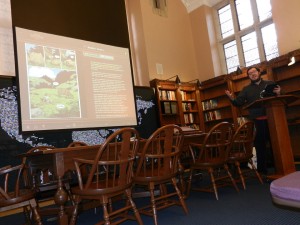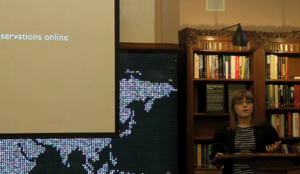This week at TwTT, Thomas Beasley, a graduate student in Classics and the annotator of the digital edition of the graphic novel, Age of Bronze, joined us to talk about the iPad edition of the comic, called Age of Bronze: Seen. Distributed by Throwaway Horse, the electronic version features not only a story line informed by a comparative literary analysis and drawings based on the best available history, but also a reader’s guide built into the app that brings historical context and archaeological foundations into the narrative. Although some people are still skeptical of the graphic novel’s role in education, Thomas points out that comics are dynamic and have been embraced by Yale as a valid form of literature, and that the addition of the reader’s guide opens the path to exploring graphic novels as teaching tools in other disciplines as well.
us to talk about the iPad edition of the comic, called Age of Bronze: Seen. Distributed by Throwaway Horse, the electronic version features not only a story line informed by a comparative literary analysis and drawings based on the best available history, but also a reader’s guide built into the app that brings historical context and archaeological foundations into the narrative. Although some people are still skeptical of the graphic novel’s role in education, Thomas points out that comics are dynamic and have been embraced by Yale as a valid form of literature, and that the addition of the reader’s guide opens the path to exploring graphic novels as teaching tools in other disciplines as well.
Although the electronic format may seem natural, before Age of Bronze was on the iPad it was a meticulously researched print comic on the history of the Trojan War. The author, Eric Shanower, sought to go beyond the well-known end to the war, recounted in Homer’s Iliad, to create a graphic retelling of the whole ten year conflict. With such a vast undertaking, no single source was sufficient. Instead, Shanower drew upon centuries of literature to create the story line. The comic is informed as much by purported first person historical accounts as by 20th century opera, resulting in a narrative that is historically grounded, but fresh and relevant to contemporary audiences.
While the story line draws on many sources across time, the actual art of the comic is based on archaeology and material culture. Buildings and sites depicted in the work will mirror the best archaeological reconstructions available, and a close examination of any frame reveals details that are based on extensive research. Figurines, jewelry, instruments, weapons, frescoes, and altars depicted in the graphic novel are all based on historical finds. Where data was not available from Troy, Shanower drew on relics from the nearby Hittite culture – trying to keep speculative drawing to a minimum.
What the electronic edition of the graphic novel does is open up all of this careful research to the reader – making it accessible from a side-pane.  When the iPad is in landscape orientation, the user can open the guide, and have access to a story summary, dramatis personae, the commentary, and a discussion area. The commentary section includes a background of the research on which scenes were based, and explains cultural and customary aspects of the story that may be easy to overlook in the comic by itself. The commentary is also interactive, providing download or purchase links for source material, as well as content useful for further research.
When the iPad is in landscape orientation, the user can open the guide, and have access to a story summary, dramatis personae, the commentary, and a discussion area. The commentary section includes a background of the research on which scenes were based, and explains cultural and customary aspects of the story that may be easy to overlook in the comic by itself. The commentary is also interactive, providing download or purchase links for source material, as well as content useful for further research.
It is the interactive aspect of the reader’s guide that makes the app a useful tool for teaching. A comic is a form of literature that is naturally easier to understand than dense academic texts or original language source material, and can also make cultural or material historical references more apparent to students. The traditional weakness, however, is that this ease of reading comes at the expense of depth. With the inclusion of a parallel reader’s guide, this weakness is overcome. Students can now not only see a character complain about “breach of hospitality,” but also read about how scholars understand classical social norms and the repercussions for violating them. When reading about the decision to go to war, the comic may present some of the surface and personal reasons for conflict, while the guide can point readers to the geopolitical situation of the time.
In addition to serving as a launch point for research and discussion, the app itself can be an engine of collaborative learning. Using the discussion feature, students can engage each other and a larger community of readers in conversation while working through the narrative. A professor using the material could assign students to add comments to certain key parts of the graphic novel, provoking research on relevant periods or at least extending dialog after hours.
While usage of Age of Bronze: Seen in the classroom is currently low, this may be a result of relatively poor exposure – many instructors will dismiss comics offhand without awareness of the resources available through a digital edition. Nonetheless, the use of sequential art in conjunction with detailed historical background is novel, and may reflect a new way to present historical narratives to students. As more digital comic editions of classic works become available, it may be that graphic novels will be more significant in the future of digital humanities and in the next generation of digital publishing than they have been historically. After all as graphic novels gain acceptance as a valid subject of academic study, and earn places alongside traditional print media in academic libraries, it seems natural that what Thomas calls “a new version for a new century” will be put to new instructional uses.
For full coverage of this session, please click the video below
(note a slight delay upon initial playback):






